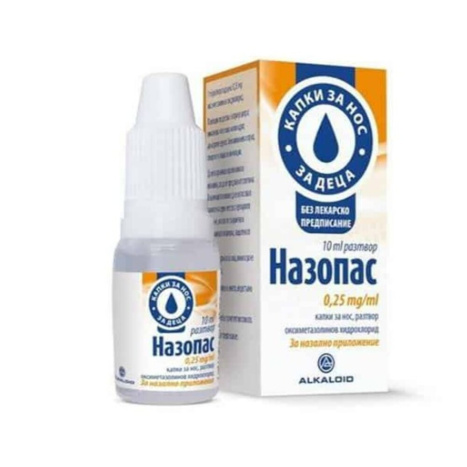NAZOPASS nasal drops 0,25mg/ml 10ml
Read all of this leaflet carefully before you start using this medicine because it contains important information for you.
Always use this medicine exactly as described in this leaflet or as your doctor or pharmacist has told you.
Keep this leaflet. You may need to read it again.
If you need further information or advice, ask your pharmacist.
If you get any side effects, tell your doctor or pharmacist. This also includes any possible side effects not described in this leaflet. See point 4
If after 5-7 days you do not feel better or your condition worsens, you should seek medical help.
What this leaflet contains
1. What Nazopas is and what it is used for
2. What you need to know before using
3. How to use Nazopas
4. Possible side effects
5. How to store Nazopas
6. Contents of the package and additional
1. What Nazopas is and what it is used for
Nasopas is for nasal use only and contains the active substance oxymetazoline hydrochloride. This active substance has vasoconstrictor properties and therefore reduces swelling of the mucous membranes.
Nazopas can be used in children aged 2 to 6 years in the following conditions:
Relief of nasal congestion associated with inflammation of the nasal mucosa (rhinitis):
accompanied by a cold (acute rhinitis);
such as hay fever (allergic rhinitis);
caused by various types of irritants (vasomotor rhinitis);
accompanied by inflammation of the lining of the sinuses (sinusitis);
accompanied by inflammation of the Eustachian tube and the middle ear.
The product can also be used to reduce mucosal swelling during medical examinations.
If after 5-7 days you do not feel better or your condition worsens, you should seek medical help.
2. What you need to know before you use Nazopas
You are not using Nazopas
if you are allergic to oxymetazoline or any of the other ingredients of this medicine (listed in section 6);
if you have any type of chronic cold where the lining of the nose dries up and crusts over (dry rhinitis);
after surgical removal of the pituitary gland (transsphenoidal hypophysectomy) and other nasal surgeries of intervention with the discovery of the dura (thick membrane that surrounds the brain);
in children under 2 years of age.
Warnings and precautions
Talk to your doctor or pharmacist before using Nasopas if you have any of the following conditions:
increased intraocular pressure or narrow-angle glaucoma (a type of glaucoma);
if you have severe cardiovascular disease (such as coronary artery disease);
if you have high blood pressure;
if you are being treated with MAO inhibitors or tricyclic antidepressants (medicines to treat depression), or other medicines that can increase blood pressure;
if you have a tumor of the adrenal gland (called pheochromocytoma);
if you have metabolic problems such as an overactive thyroid gland (hyperthyroidism) or diabetes;
if you have an enlarged prostate (prostatic hypertrophy);
if you have a disease known as porphyria (substances called porphyrins that negatively affect the skin or nervous system).
Long-term use of nasal drops to relieve nasal congestion may cause reactive hyperemia (known as the rebound effect), chronic swelling, and eventual atrophy of the nasal mucosa.
In the case of patients with chronic rhinitis, oxymetazoline should only be used intermittently and under medical supervision due to the risk of mucosal atrophy (thinning of the nasal mucosa).
Avoid long-term use and overdose.





